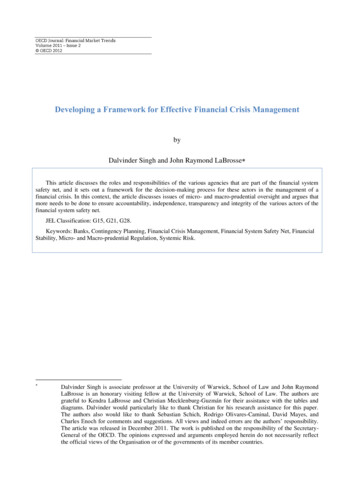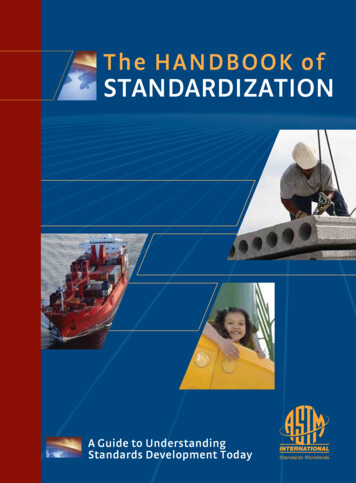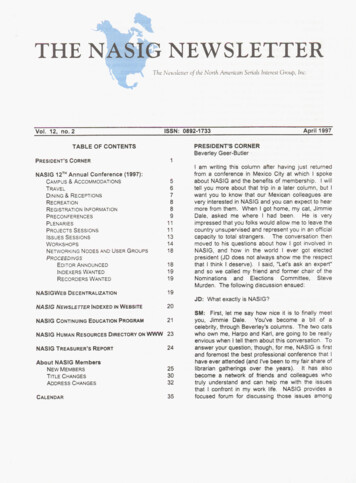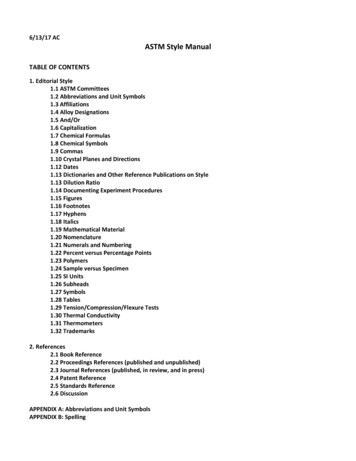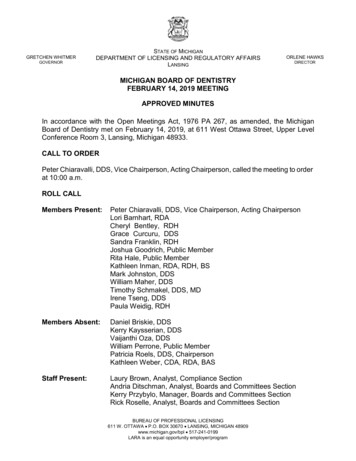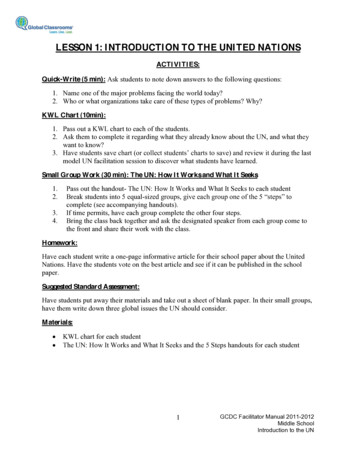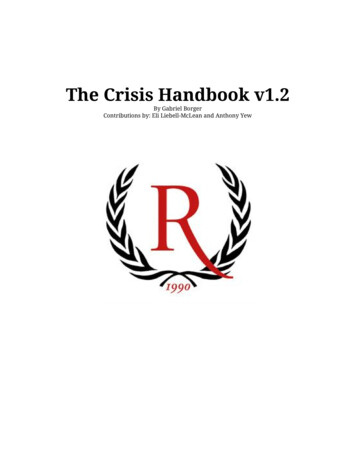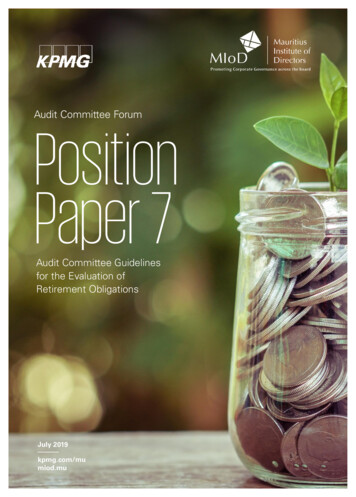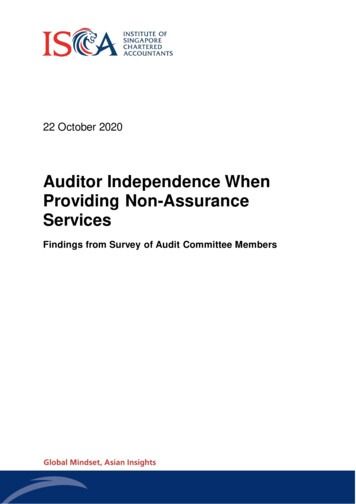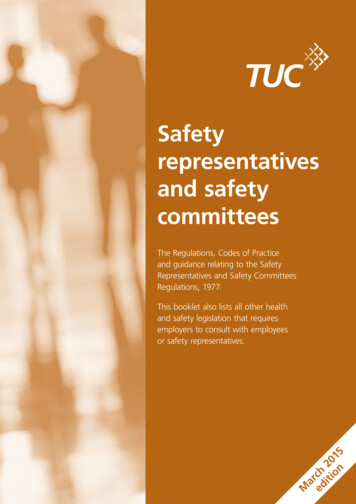
Transcription
Safetyrepresentativesand safetycommitteesThe Regulations, Codes of Practiceand guidance relating to the SafetyRepresentatives and Safety CommitteesRegulations, 1977.Mared chiti 20on 15This booklet also lists all other healthand safety legislation that requiresemployers to consult with employeesor safety representatives.
Crown copyright 2014First published 2008Second edition 2012Third edition 2014ISBN 978 0 7176You may reuse this information (excluding logos) free of charge in any format ormedium, under the terms of the Open Government Licence. To view the licencevisit cence/, write to theInformation Policy Team, The National Archives, Kew, London TW9 4DU, oremail psi@nationalarchives.gsi.gov.uk.Some images and illustrations may not be owned by the Crown so cannot bereproduced without permission of the copyright owner. Enquiries should be sentto copyright@hse.gsi.gov.uk.Approved Code of PracticeThis Code has been approved by the Health and Safety Executive, with theconsent of the Secretary of State. It gives practical advice on how to comply withthe law. If you follow the advice you will be doing enough to comply with the lawin respect of those specific matters on which the Code gives advice. You may usealternative methods to those set out in the Code in order to comply with the law.However, the Code has a special legal status. If you are prosecuted for breachof health and safety law, and it is proved that you did not follow the relevantprovisions of the Code, you will need to show that you have complied with thelaw in some other way or a Court will find you at fault.GuidanceThis guidance is issued by the Health and Safety Executive. Following theguidance is not compulsory, unless specifically stated, and you are free to takeother action. But if you do follow the guidance you will normally be doingenough to comply with the law. Health and safety inspectors seek to securecompliance with the law and may refer to this guidance.
ContentsIntroduction by the TUC.1Preface.3Background.4Introduction.5Consulting where both sets of regulations apply.8Resolving disputes.8Part 1 Safety Representatives and Safety Committees Regulations 1977(as amended).7Regulation 1Citation and commencement.7Regulation 2Interpretation.8Regulation 3Appointment of safety representatives.9Regulation 4Functions of safety representatives.12Regulation 4AEmployer’s duty to consult and provide facilitiesand assistance.13Schedule 2Pay for time off allowed to safety representatives.13Regulation 5Inspections of the workplace.22Regulation 6Inspections following over-three-day-injuries, notifiableaccidents, dangerous occurrences and diseases.26Regulation 7Inspection of documents and provision of information.26Regulation 8Cases where safety representatives need not be employees.27Regulation 9Safety committees.28Regulation 10Power of Health and Safety Commission togrant exemptions.32Regulation 11Provisions as to [employment tribunals].32Appendix 1.34Appendix 2.44Appendix 3.52
4
Introduction bythe TUCTrade unions have always played a vital role in ensuring that people go home safeand well from their work. We know that the safest and healthiest workplacesare those where organisations involve their trade union health and safetyrepresentatives. Engaging them in decisions about health and safety providesopportunities for: their practical knowledge of the work to be shared concerns to be raised and solutions offered the workforce to have a say a culture of good health, safety and welfare which is achieved through trustand consensus.This is recognised by our health and safety laws which set down legal obligationson employers to work with recognised trade unions in the belief that this is thebest way to develop a positive health and safety culture in the workplace.Culture of cooperationSection 2(6) of the Health and Safety at Work Act 1974 obliges employers tomake and maintain arrangements that will enable employer and employees“to cooperate effectively in promoting and developing measures to ensure thehealth and safety at work of the employees” and thereafter checking thesemeasures work. So the arrangements for cooperation are an indicator of employercommitment: the priority given to protecting people’s lives.Legal statusThis book, known as the ‘Brown Book’ (because of its origins), is an extract fromthe Health and Safety Executive (HSE) publication called Consulting workers onhealth and safety. Safety Representatives and Safety Committees Regulations1977 (as amended) and Health and Safety (Consultation with Employees)Regulations 1996 (as amended). Approved Codes of Practice and guidance(a).HSE calls it L146 for short. The Brown Book only contains the 1977 regulations(plus associated code of practice and guidance) which are reproduced with HSE’spermission. The rest of L146 has no relevance to organisations where tradeunions are recognised.Using the Brown Book in your organisationWhere trade union health and safety representatives are appointed and active,they offer a sole means of consulting and engaging with everyone in theworkforce. Trade unions and their employers may therefore use the Brown Booksafe in the knowledge that it outlines the health and safety consultation lawapplicable to their workplace.It complements good practice guidance developed by HSE with Acas (theAdvisory, Conciliation and Arbitration Service) called Involving your workforcein health and safety: Good practice for all workplaces (HSG263)(b).(a)(b)L146 (second edition) published in 2014 (ISBN 978 0 7176 6461 0)HSG263 published in 2008 (ISBN 978 0 7176 6227 2)1
Use both publications to stimulate the development and agreement of yourorganisation’s policy and arrangements for effective worker involvement.This will ensure best practice in promoting health and safety, assessing theimpact of evolving strategy (such as new technologies and organisationalchange) and protecting people from harm. Buy-in and consensus can result inthe achievement of high standards of health and safety, boosting organisationalmorale and reputation.The table below provides a summary of what good and bad worker involvementlook like.What effective cooperation lookslikeWhat it looks like when done badlyor not at all There is provision of informationand training to enable staffto work in a safe and healthymanner. There are no arrangements ormeasures to enable health andsafety cooperation between theemployer and workforce. Trade union H&S representativescarry out their full range offunctions either independentlyor, if agreed, jointly withmanagement. Employees lack the right level ofinformation or training needed todo their job in a safe and healthymanner. Trade union H&S representativesare involved in risk assessment. Trade union H&S representativesare consulted in good time onmatters relating to their healthand safety and the results of riskassessments (e.g. systems of workincluding procedures). Suggestions made by tradeunion H&S representatives areconsidered before health andsafety decisions are made with anexplanation from management ifsuggestions are rejected. Trade union H&S representativesare comfortable and supportedin reporting unsafe acts andconditions. The company has keyperformance indicators for workerinvolvement, progress againstwhich is reviewed and reported.2 Trade union H&S representativesare not supported to carry outtheir functions. Risk assessments are madewithout worker engagement. Change and new technologiesare introduced without involvingtrade union H&S representativesin assessing any health and safetyimpact. Health and safety controls are notpractical, forcing workers to workaround difficulties. No supervisor/line managerdiscussion of:- how to do a job safely- the safe use of new equipment. Workers do not know how toreport health and safety concernsor fear making a report willdisadvantage them. There is little or no evidenceof information being cascadedthrough the organisation.
PrefaceThe law requires you to consult your employees on matters that affect theirhealth and safety. There are two sets of regulations that deal with this subjectaccording to the circumstances in your workplace, so this book is split into twoparts. Part 1 contains:(a)(b)(c)(d)the Safety Representatives and Safety Committees Regulations 1977(SI 1977/500), as amended by the Employment Rights (Dispute Resolution)Act 1998 Chapter 8, the Management of Health and Safety at WorkRegulations 1992 (SI 1992/2051), the Health and Safety (Consultationwith Employees) Regulations 1996 (SI 1996/1513), the Fire Precautions(Workplace) Regulations 1997 (SI 1997/1840), the Police (Health andSafety) Regulations 1999 (SI 1999/860), the Quarries Regulations 1999(SI 1999/2024), the Management of Health and Safety at Work Regulations1999 (SI 1999/3242), the Serious Organised Crime and Police Act 2005(Consequential and Supplementary Amendments to Secondary Legislation)Order 2006 (SI 2006/594) and the Regulatory Reform (Fire Safety) Order2005 (SI 2005/1541);the Code of Practice on safety representatives;the Code of Practice on time off for the training of safety representatives;guidance on the Regulations.Part 2 contains:(a)(b)the Health and Safety (Consultation with Employees) Regulations 1996(SI 1996/1513), as amended by the Employment Rights (Dispute Resolution)Act 1998 Chapter 8, the Fire Precautions (Workplace) Regulations 1997(SI 1997/1840), the Management of Health and Safety at Work Regulations1999 (SI 1999/3242), and the Regulatory Reform (Fire Safety) Order 2005(SI 2005/1541);guidance on the Regulations.The regulations are shown in italics, the Codes of Practice on the SafetyRepresentatives and Safety Committees Regulations 1977 are shown in bold,and the guidance on regulations is in plain text. The relevant Code and guidanceappear alongside each regulation.The Safety Representatives and Safety Committees Regulations were made undersections 2(4), 2(7), 15(1), 15(3)(b), 15(5)(b), 80(1) and 80(4) of the Health andSafety at Work etc Act 1974 (HSW Act), as amended by paragraphs 2, 6 and 19of Schedule 15 to the Employment Protection Act 1975.The Health and Safety (Consultation with Employees) Regulations were madeunder powers in section 2 of the European Communities Act 1972.The Approved Codes of Practice were made under section 16 of the HSW Actand under the Safety Representatives and Safety Committees Regulations 1977by the then Health and Safety Commission to give some practical guidelines onthose Regulations.3
BackgroundThe former Health and Safety Commission decided that it would be wrong to tryand make regulations which cater in detail for the wide variety of circumstancesin which they will have to be applied. Accordingly, the purpose of the SafetyRepresentatives and Safety Committees Regulations and Codes of Practice is toprovide a legal framework for employers and trade unions to reach agreementon arrangements for health and safety representatives and health and safetycommittees to operate in their workplace.The Health and Safety (Consultation with Employees) Regulations set out thelegal framework which will apply if employers have employees who are notcovered by representatives appointed by recognised trade unions. It is possibletherefore that in some workplaces employers may have to consult under bothsets of regulations. The purpose of both sets of regulations is to provide aframework within which employers can develop effective working arrangementsto suit their business.To supplement the statutory framework, the revised guidance helps to clarifywhat the law means. The Health and Safety Executive (HSE) hope it willbe of help to employers, trade unions, appointed and elected health andsafety representatives, and members of health and safety committees. Thissecond edition, originally published in 2012, has been subject to some minoramendments and corrections to reflect changes to linked HSE guidance andrevisions/revocations to other, related pieces of legislation. The guidance remainssubstantially the same.Further good practice guidance for employers is available in Involving yourworkforce in health and safety (HSG263).Employers and employees can agree to alternative arrangements for jointconsultation on health and safety at work as long as such arrangements donot detract from the rights and obligations created by the above regulations.Recognised trade unions can at any time invoke the rights given by the SafetyRepresentatives and Safety Committees Regulations and the obligations on theemployer would then apply.4
Introduction1This book gives you advice on how to consult and involve your employeesand their representatives on health and safety matters at work under the SafetyRepresentatives and Safety Committees Regulations 1977 (as amended) and theHealth and Safety (Consultation with Employees) Regulations 1996 (as amended).2It complements the guide Involving your workforce in health and safety(HSG263). There is also a free leaflet, Consulting employees on health andsafety: A brief guide to the law (INDG232(rev1)), as well as advice on HSE’swebsite at www.hse.gov.uk/involvement.3This book should apply to the majority of workplaces. However, theOffshore Installations (Safety Representatives and Safety Committees)Regulations 1989 apply to offshore workplaces. There are also specificrequirements to consult your employees or their health and safety representativesin other health and safety legislation which applies to specific industries. Whereit is more appropriate and relevant, you should refer to industry-specific guidancefor your workplace.4The law sets out how you must consult your employees in differentsituations and the different choices you have to make. In some workplaces youmay have to consult under both sets of regulations. There is more advice on therelationship between the two sets of regulations and how they affect you andyour workforce in Involving your workforce in health and safety (HSG263).Consulting where both sets of regulations apply5A range of workforce structures and arrangements exist in workplaces so itis not unusual to have some parts of a business where employees are members ofrecognised trade unions and others where they are not. In this case, you may haveto consult both:(a)(b)health and safety representatives (called ‘safety representatives’ in theRegulations) appointed by recognised trade unions under the SafetyRepresentatives and Safety Committees Regulations 1977;the remainder of your workforce, either directly where practical, or throughelected health and safety representatives (called ‘representatives of employeesafety’ in the Regulations) under the Health and Safety (Consultation withEmployees) Regulations 1996.6Where you already have existing consultation arrangements that satisfyhealth and safety law, there is no requirement to change them. However, you maywant to review your arrangements to make sure that they are the right ones foryour organisation now.Resolving disputes7Disagreements that may arise between employers and trade unions oremployees on the interpretation of these regulations should be settled through thenormal machinery for resolving employment relations problems. The exceptionsto this are matters covered by regulation 11 in the Safety Representatives andSafety Committees Regulations and regulation 7(3) Schedule 2 of the Health andSafety (Consultation with Employees) Regulations.5
8In certain circumstances, it may be helpful to involve the Advisory,Conciliation and Arbitration Service (Acas). Health and safety inspectors(from HSE and local authorities) can enforce for failure to comply with legalduties on procedural matters (eg failure to set up a health and safety committeewhere there is evidence that a request has been made in the correct fashion).They will apply HSE’s Enforcement policy statement in deciding what actionto take (see www.hse.gov.uk/enforce).9There are two circumstances in which representatives may present acomplaint to an employment tribunal – if employers have failed to allow time off,or if they have failed to pay health and safety representatives while carrying outtheir functions, or undergoing training. The time off with pay must be necessaryand the training must be reasonable in all the circumstances (see paragraphs 42and 43). Health and safety representatives are also protected against victimisationand dismissal by rights conferred under other employment legislation (forexample part of the Employment Rights Act 1996).6
Part 1 Safety Representatives and Safety CommitteesRegulations 1977 (as amended)(a)Regulation 1Regulation 1Code of Practice 1Citation and commencementThese Regulations may be cited as the Safety Representatives and SafetyCommittees Regulations 1977 and shall come into operation on 1 October 1978.10 The Safety Representatives and Safety Committees Regulations 1977concern safety representatives appointed in accordance with section 2(4) of theHealth and Safety at Work etc Act 1974 (the HSW Act) and cover:(a)(b)prescribed cases in which recognised trade unions may appoint safetyrepresentatives from among the employees;prescribed functions of safety representatives.11 Section 2(6) of the Act requires employers to consult with safetyrepresentatives with a view to the making and maintenance of arrangements whichwill enable them and their employees to co-operate effectively in promoting anddeveloping measures to ensure the health and safety at work of the employees,and in checking the effectiveness of such measures. Under section 2(4) safetyrepresentatives are required to represent the employees in those consultations.12 This Code of Practice was approved by the Health and Safety Commissionwith the consent of the Secretary of State for Employment. It relates to therequirements placed on safety representatives by section 2(4) of the Act and onemployers by the Regulations and takes effect on the date the Regulations comeinto operation.13 The employer, the recognised trade unions concerned and safetyrepresentatives should make full and proper use of the existing agreed industrialrelations machinery to reach the degree of agreement necessary to achieve thepurpose of the Regulations and in order to resolve any differences.(a)Safety Representatives and Safety Committees Regulations 1977 (SI 1977/500) as amended by1998 c.8, SI 1992/2051, 1996/1513, 1997/1840, 1999/860, 1999/2024, 1999/3242 and 2006/594.Guidance 1Consulting employees if you recognise a trade union14 The Safety Representatives and Safety Committees Regulations 1977(as amended) prescribe the cases in which recognised trade unions may:(a)(b)(c)appoint health and safety representatives;specify the functions of such health and safety representatives;set out the obligations of employers towards them.15 When appointing health and safety representatives, the trade union shouldinform the employer of the group or groups of employees represented. Forexample, they may say a health and safety representative will represent:(a)(b)(c)only their own members;all the employees in a particular category; oremployees who are not members of a trade union recognised by the employer,but are part of a group of employees for which a union is recognised.7
Guidance 116 If union health and safety representatives cover only their own members, oremployees are not members of a group that unions have agreed to cover, then theemployer needs to make arrangements to consult these employees either directlyor through representatives elected by them for this purpose under the Health andSafety (Consultation with Employees) Regulations 1996. For more informationsee Part 2 of this publication.17 Disagreements between employers and employees about the interpretationof these Regulations – with the exception of matters covered by regulation 11– should be addressed through the normal machinery for resolving employmentrelations disputes. In certain circumstances, it may be helpful to involve Acas.Regulation 2Regulation 2Interpretation(1)In these Regulations, unless the context otherwise requires –“the 1974 Act” means the Health and Safety at Work etc. Act 1974;“the 1975 Act” means the Employment Protection Act 1975;“employee” has the meaning assigned by section 53(1) of the 1974 Act and“employer” shall be construed accordingly;“recognised trade union” [ . ](a) means an independent trade union as definedin section 30(1) of the Trade Union and Labour Relations Act 197 4(b) whichthe employer concerned recognises for the purpose of negotiations relating to orconnected with one or more of the matters specified in section 29(1) of that Actin relation to persons employed by him or as to which the Advisory, Conciliationand Arbitration Service has made a recommendation for recognition under theEmployment Protection Act(c) which is operative within the meaning of section15 of that Act;“safety representative” means a person appointed under Regulation 3(1) of theseRegulations to be a safety representative;“welfare at work” means those aspects of welfare at work which are the subjectof health and safety regulations or of any of the existing statutory provisionswithin the meaning of section 53(1) of the 1974 Act;“workplace” in relation to a safety representative means any place or placeswhere the group or groups of employees he is appointed to represent are likely towork or which they are likely to frequent in the course of their employment orincidentally to it.(a)Inserted by the Police (Health and Safety) Regulations 1999 and revoked by the SeriousOrganised Crime and Police Act 2005 (Consequential and Supplementary Amendments to SecondaryLegislation) Order 2006.(b)1974 c.52. The relevant law is now found in the Trade Union and Labour Relations(Consolidation) Act 1992. Section 178(3) defines recognition as ‘recognition of the union byan employer, or two or more associated employers, to any extent, for the purpose of collectivebargaining’. Collective bargaining is defined by reference to the matters listed in section 178(1).These include, for example, negotiations on terms and conditions of employment, allocation of workand duties of employment between workers or groups of workers, and disciplinary matters.(c)This refers to former procedure and is now irrelevant. See section 70A and Schedule A 1 to theTrade Union and Labour Relations (Consolidation) Act 1992.8
Regulation 2(2) The Interpretation Act 1889(a) shall apply to the interpretation of theseRegulations as it applies to the interpretation of an Act of Parliament.(3) These Regulations shall not be construed as giving any person a rightto inspect any place, article, substance or document which is the subject ofrestrictions on the grounds of national security unless he satisfies any test orrequirement imposed on those grounds by or on behalf of the Crown.[Regulation 2A Bodies to be treated as recognised trade unions](b)(a)1889 c.63. The Interpretation Act 1978 (1978 c.30) is now in force.(b)Regulation 2A inserted by the Police (Health and Safety) Regulations 1999 and revoked by theSerious Organised Crime and Police Act 2005 (Consequential and Supplementary Amendments toSecondary Legislation) Order 2006.Code of Practice 218In this Code:(a)‘the 1974 Act’ means the Health and Safety at Work etc Act 1974 and‘the Regulations’ means the Safety Representatives and Safety CommitteesRegulations 1977 (SI 1977 No 500);*words and expressions which are defined in the Act or in the Regulationshave the same meaning in this Code unless the context requires otherwise.(b)* As amended by 1998 c8, Sls 1992/2051, 1996/1513, 1997/1840, 1999/860, 1999/2024, 1999/3242and 2006/594.Regulation 3Regulation 3Appointment of safety representatives(1) For the purposes of section 2(4) of the 1974 Act, a recognised tradeunion may appoint safety representatives from amongst the employees in allcases where one or more employees are employed by an employer by whomit is recognised.(2) Where the employer has been notified in writing by or on behalf ofa trade union of the names of the persons appointed as safety representativesunder this Regulation and the group or groups of employees they represent, eachsuch safety representative shall have the functions set out in Regulation 4 below.(3) A person shall cease to be a safety representative for the purposes ofthese Regulations when –(a)(b)(c)the trade union which appointed him notifies the employer in writingthat his appointment has been terminated; orhe ceases to be employed at the workplace but if he was appointed torepresent employees at more than one workplace he shall not cease byvirtue of this sub-paragraph to be a safety representative so long as hecontinues to be employed at any one of them; orhe resigns.(4) A person appointed under paragraph (1) above as a safetyrepresentative shall so far as is reasonably practicable either have been employedby his employer throughout the preceding two years or have had at least twoyears experience in similar employment.9
Guidance 319 When the Safety Representatives and Safety Committees Regulations wereintroduced, employees in a mine were specifically excluded from the provisionof section 3(1). This was amended by regulation 13 of the Health and Safety(Consultation with Employees) Regulations 1996, so that recognised trade unionscan now appoint safety representatives to represent employees working at coalmines. This change does not affect the provision in the Mines and Quarries Act1954 for the appointment of workers’ inspectors.20 Although there is some overlap between that provision and regulation 5 ofthe Safety Representatives and Safety Committees Regulations 1977, HSE believesthat, in practice, employers and trade unions will be able to reach agreement onarrangements which will meet the requirements of both the Mines and QuarriesAct 1954 and the Safety Representatives and Safety Committees Regulations 1977.Who appoints health and safety representatives?21 The Regulations mean that recognised trade unions may appoint healthand safety representatives to represent the employees. Any disputes betweenemployers and trade unions about recognition should be dealt with through thenormal employment relations machinery. Acas can offer advice and guidancerelating to trade union recognition issues, and may provide conciliation wherethere is a dispute.Deciding who to appoint as a health and safety representative22 The Regulations require appointed health and safety representatives tonormally have either worked for their present employer throughout the precedingtwo years or have had at least two years’ experience in similar employment. Thisis to ensure they have the necessary experience and knowledge of their particulartype of work to enable them to make a responsible and practical contributionto health and safety in their workplace. However, circumstances may arisewhere it will not be reasonably practicable for the appointed health and safetyrepresentative to possess such experience (eg where the employer or workplacelocation is newly established, where work is of short duration, or where thereis a high labour turnover). In such cases, trade unions will appoint the mostappropriate representatives, in relation to their experience and skills.Who do health and safety representatives represent?23 Normally, recognised trade unions will appoint representatives to representa group or groups of workers of a class for which the union has negotiatingrights. However, limiting representation to a particular group or groups shouldnot be regarded as a hindrance to the representative raising general mattersaffecting the health and safety of employees as a whole.24 Equally, these general principles do not prevent a health and safetyrepresentative representing, by mutual agreement between the appropriate unions,more than one group or groups of employees (eg in a small workplace or withinthe organisation of a small employer when the number of recognised trade unionsis high relative to the total numbers employed).10
Guidance 325 Additionally, a health and safety representative employed by the sameemployer can represent employees who do not work at the same site asthem. There is nothing in these Regulations to prevent a health and safetyrepresentative being appointed to represent a group of employees at more thano
This book, known as the ‘Brown Book’ (because of its origins), is an extract from the Health and Safety Executive (HSE) publication called Consulting workers on health and safety. Safety Representatives and Safety Committees Regulations 1977 (as amended) and Health and Safety (Co
